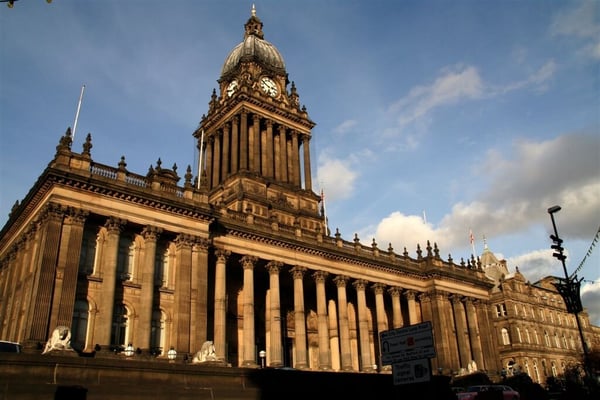CEO of Digital Iceland: “We’re like a big tech start-up”
Much like its ever changing landscape, Iceland, as a digital nation, is constantly on the move. Despite representing a small country of just 370,000 people, in just three years it has shot up to 5th place in the UN’s global e-Government index.
Responsibilities for digital government are led largely by Digital Iceland. The agency, which was created in 2018 and sits within the Ministry of Finance, works cross-government to build and centralise digital services.
Following the country’s rapid rise through the ranks of digital government, we spoke to the CEO of Digital Iceland, Andri Heiðar Kristinsson. Since taking on the role in 2020, Kristinsson has overseen many of the reforms that have made Iceland’s transformation possible.
He says today, almost 38 percent of Icelanders access government services via the Digital Iceland App. Furthermore, a growing portion of paper-based processes now have digital alternatives: 60 percent of driving licences are now digital and on mobile phones and employees spend 80 percent less time processing paperwork for this service than they did before the App.
Digital Iceland is currently on a journey to condense all government services into one place through Island.is, alongside an accompanying digital app for all government tasks, digital mail and processes across Iceland’s government agencies.
While many are quick to judge Iceland’s size as a limitation, Kristinsson sees it as an advantage: “We are small and nimble, which means we pivot quickly. While we were lacking a few years ago, I saw a big opportunity to change that given the high-level of education and technology infrastructure here. I saw that Iceland had all the ingredients to become one of the leaders in the world for digital government.”
So what has allowed this small country with limited resources to unlock its full digital potential?
An entrepreneurial spirit
After spending time with Kristinsson, it's clear he is not afraid to break from the mould; a philosophy ingrained in him from time spent scaling travel start-ups, teaching entrepreneurship at Reykjavik university and doing an MBA at Stanford. Unlike most bureaucrats, who often end up leaving for greener pastures in the private sector, Kristinsson has done it the other way around. He views his exit from Silicon Valley and subsequent entry into government as a “tour of duty”. He saw the potential of Iceland and, determined to make a change, embarked on a mission to shake things up.
“Throughout my career, the common themes have been innovation and transformation,” Kristinsson says. These values, alongside his entrepreneurial instincts, are being put to good use in his role at the helm of Digital Iceland. “Sometimes it feels like we're building up a start-up within a government. This means breaking the rules a little bit, building on traditional skills of innovation and accepting failure and feedback loops. It’s important that we act and think like a big tech start-up.”
Kristinsson explains that Digital Iceland was set up precisely with this anti-bureaucratic spirit in mind. He says the agency was tasked with “re-thinking how the government should operate” and to that end, has its own independent funding; giving it the capacity and autonomy to deliver. This flexibility has allowed Digital Iceland to move fast and innovate government services quickly.
Borrowing from the best
As a small country, the Icelandic government has to be innovative in terms of how they can achieve the right level of service. One way its digital government has set itself up for success is by borrowing the best ideas from other countries.
Kristinsson says they have hugely benefited from stepping on the shoulders of other smaller nations with a high adoption of technology, such as Estonia and Finland. Over the years, Iceland has formed close collaborations with these countries in order to get a jump start on digital initiatives - as highlighted in the X-Road data exchange layer, an automated data exchange between the Nordic countries.
One of Digital Iceland’s current priorities is scaling Island.is, a central hub for all services and information provided by the Icelandic government agencies. Kristinsson says they took inspiration from GOV.UK when building the platform, hence its rapid growth in such a short space of time: so far 15 public entities have moved their website to Ísland.is, 27 additional public entities are in the process and several new services are to be added to platform this year.
“Despite being small, we still have to deliver all the same services as countries bigger than us,” he notes. “We don't have the resources of people or the capital to build everything from scratch and invent everything so we have to be really selective about where we invest our time and money.”
Being innovative does not always mean being unique. In fact, Kristinsson believes the two concepts can sometimes work against each other. “We are using classical tools and then adapting them to fulfil our own needs and environment. Picking the best examples, learning and getting quickly up to speed and then being able to deploy our resources to innovate on top of that really sets us up for success.”
Fostering innovation
As a sparsely populated country, access to digital skills is an ongoing challenge in Iceland - despite having a highly digitally literate population.
One of Digital Iceland’s approaches has been a large-scale procurement of 20 different software development teams, says Kristinsson. “We're procuring talent and experience beforehand so you can deploy them in a really productive way. We are moving away from that traditional, drawn out procurement process. It has a critical success factor for us in terms of being able to move fast and innovate quickly”
An underlying theme for the Iceland's transformation journey has been innovation through collaboration. Kristinsson says Digital Iceland collaborates heavily on research and seeks to spread knowledge through a centre of excellence with 14 technology partners.
This commitment to education and transparency extends to Iceland’s widespread use of open source software. Roughly 90% of government information systems from the public sector are now open source - something Kristinsson says avoids a digital lock-in. “We want to be open and share data. We’re building everything in a modern tech stack so everything is in the Cloud or we use open source-software in most places where we can.”
Kristinsson also recognises the importance of fostering the right culture. “I tell my team when you're playing in your local clubs in soccer you compete fiercely with one another, but then you get chosen to the national team - or in our case government - and you must work together for the greater good of our country. I think that really has struck a tone that resonates with a lot of people.”
Satisfied citizens
Perfection, as they say, is the enemy of progress. This is why Digital Iceland chooses to take a more agile approach to digital government; releasing new products and services in iterations over time.
Kristinsson points to the digital registration for maternity and paternity leave as an example of this. Since the initial opening of digital applications for maternity/paternity leave and grants in 2022, the focus has been on improving the functioning of the application process over time to include all groups and situations, he says. Now, 91% of citizens are choosing to apply for paternity/maternity leave online on a platform which is accessible to 97% of the population.
It is important to continuously monitor the user experience, Kristinsson adds. “We're constantly looking at what people are telling us and getting feedback about our products.” The agency even have 'influencers for island.is' - citizens who have volunteered to become agents for the digital projects being developed at Digital Iceland. So far, they have 237 people 'influencers' who have given their views and feedback on several projects.
Digital Iceland built the Ísland.is App for its core platform a little over a year ago. Now, over a third of the population has already downloaded it and uses it on a regular basis. One of the App’s most recent innovations is a digital mailbox where citizens can opt in to receive messages from government agencies.
The agency are currently focused on making it feel more personalised, Kristinsson says. He cites findings, which reveal most Icelanders are not aware of what services are available so cannot know where to start looking for them. As such, the next step is to implement push notifications, alerting users to what specific services are available to them throughout their life.
Kristinsson notes the benefits this brings for seamless digital service. “I think that this is going to be the next wave of innovation and digital government: being more proactive and really thinking this from the user perspective. Sometimes it feels like agencies are just there to fulfil themselves and maintain the status quo. But we're trying to change the mindset by really looking at it through citizens' eyes.”
This mindset-shift could explain why citizen satisfaction with the Icelandic government remains high: a survey in November 2022 shows 75% of respondents are satisfied with the website Ísland.is, 68% are satisfied with My pages, and 69% with the Digital mailbox.
The speed with which the Icelandic government went digital - 100% paper to 90% digital in one year - means the government is paying close attention to digital exclusion risks, particularly around the elderly and disabled, says Kristinsson. One initiative they have rolled out is a digital power of attorney, which means users with an eID can give another individual access to their own digital inbox on Ísland.is.
Watch this space
Iceland’s relationship with AI is reflective of the country’s ability to turn a defensive position into an opportunity to innovate. In an unexpected turn of events, Iceland has partnered with OpenAI to use the Icelandic language in data training for GPT-4 in an effort to preserve the country’s native tongue.
Kristinsson says this is a “sign of things to come” in terms of the government's AI strategy. For now, however, he explains that they are primarily focused on delivering services and building the foundations for sharing data. “Because if you don't have the data, it's hard to build meaningful AI on top of it. But we are definitely focusing on some cool things like the language.”






